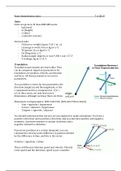Basic biomechanics extra 7-2-2019
Units
Units are given in SI. Base BBS1004 units:
- kg (mass)
- m (length)
- s (time)
- s (electric current)
Derived units:
- N (force or weight; kg.m.s-2) (F = m . a)
- J (energy or work; N.m or kg.m2.s-2)
- W (power; J/s or kg.m2.s-3)
- Hz (frequency; s-1)
- Radian (angle; degrees or m.m-1) NB 1 rad = 57.3˚
- V (voltage; kg.m2.s-3.A-1)
Translation
Translation and rotation are much alike. They
can be compared. Important parameters for
translation are position, velocity, acceleration
and force. All these parameters are vector
parameters.
You can define a vector by two parameters, the
direction (angle (α) and the magnitude, or the
x component and its y component (α, √(x2 +
y2). In this course, we only look in two
dimensions, although we know there are three.
Mnemonics in trigonometry: SOH-CAH-TOA (SOS-CAS-TOA in Dutch)
- Sine = opposite / hypotenuse
- Cosine = adjacent / hypotenuse
- Tangent = opposite / adjacent
You should understand this, but you are not expected to make calculations. You have a
positive x direction and a positive y direction, and you also have positive and negative
moments. A positive moment is counter clockwise and a
negative moment is clockwise.
If you have positions at a certain timepoint, you can
calculate the velocity as the difference in position divided
by the difference in time, and this is the vector.
Velocity = Δposition / Δtime
There is difference between speed and velocity. Velocity
is the speed and the direction, speed is just a number.
,Acceleration is the change in velocity divided by the time. It is
the green vector that is showed in the image on one page
back.
The table on the right shows the values of the speed and the
acceleration with different speeds. When you are speeding up,
the direction of speed and acceleration increase both. When
you are running with a constant speed, the direction of the
speed is still positive, but there is no acceleration. When you
are slowing down, the direction of speed is still positive, but
the acceleration is negative (no speeding up, but slowing
down).
Newton’s laws:
- 2nd: ∑F = m * a (if you exert a force on the ball, the ball will accelerate)
- 3rd: Faction = - Freaction (if you exert a force on the ball, the ball will exert an
equal but opposite force on you)
Rotation
Important parameters: angle, angular velocity, angular
acceleration and torque (moment). The torques are the most
important in joint movements.
Joint angle: dependent on convention. A fully extended knee
can be called 0˚ or 180˚. An ankle joint might be called 0˚ or
90˚.
The angular velocity = Δ joint angle / Δ time
Angular acceleration =Δ angular velocity / Δ time
Torque (moment)
Moment = force*distance to the axis
M = Fxd (N.m)
d = moment arm = lever arm
The biceps picture shows a flexing moment, and this moment is anti-clockwise, so it is a
positive moment. In 3D, there are 3 actions of rotation → 3 torques
,If you make an actual movement, then the joints only make rotations, while the pointer
makes a translation. Body movements are caused by joint rotations.
Energy
Potential energy: Ep = m.g.h; “height”
Kinetic energy: Ek = ½. m. v2; “velocity”
Elastic energy → stored in for example tendons
Work = “muscle force times change in length” = ∫Fds =
F.s.cos(α) → If the change in position and the force are
not in the same direction, you should at an additional
factor regarding the angle between the two, the cos(α)
When you jump, the muscles increase the potential
energy, the quadriceps muscle shortens, and the change in length and the force are in
the same direction, and they increase the energy.
When you come down from your jump, you use the same muscles, they generate force in
the same direction, but the muscles will elongate. The cosine will be negative and this
will decrease the energy.
Muscles can be used as a motor, but also as a brake. As a motor, they deliver positive
energy and they increase the energy in the total system. If they deliver negative work,
they decrease the total energy in the system.
, Power
The power is the work per unit time = W / Δt
Muscle work = muscle force * Δ length
The length of the muscle is sinusoidally variated. The
muscle is activated electrically. The muscle force is
measured. The force of the muscle is given in red and the
length of the muscle is give in blue. If the muscle is
stimulated electrically it will contract, a force will be
generated, but this force does not have any effect on the
change in length, because we have a large motor which can
make this sinusoidal movement irrespective of the force
created by the muscle.





